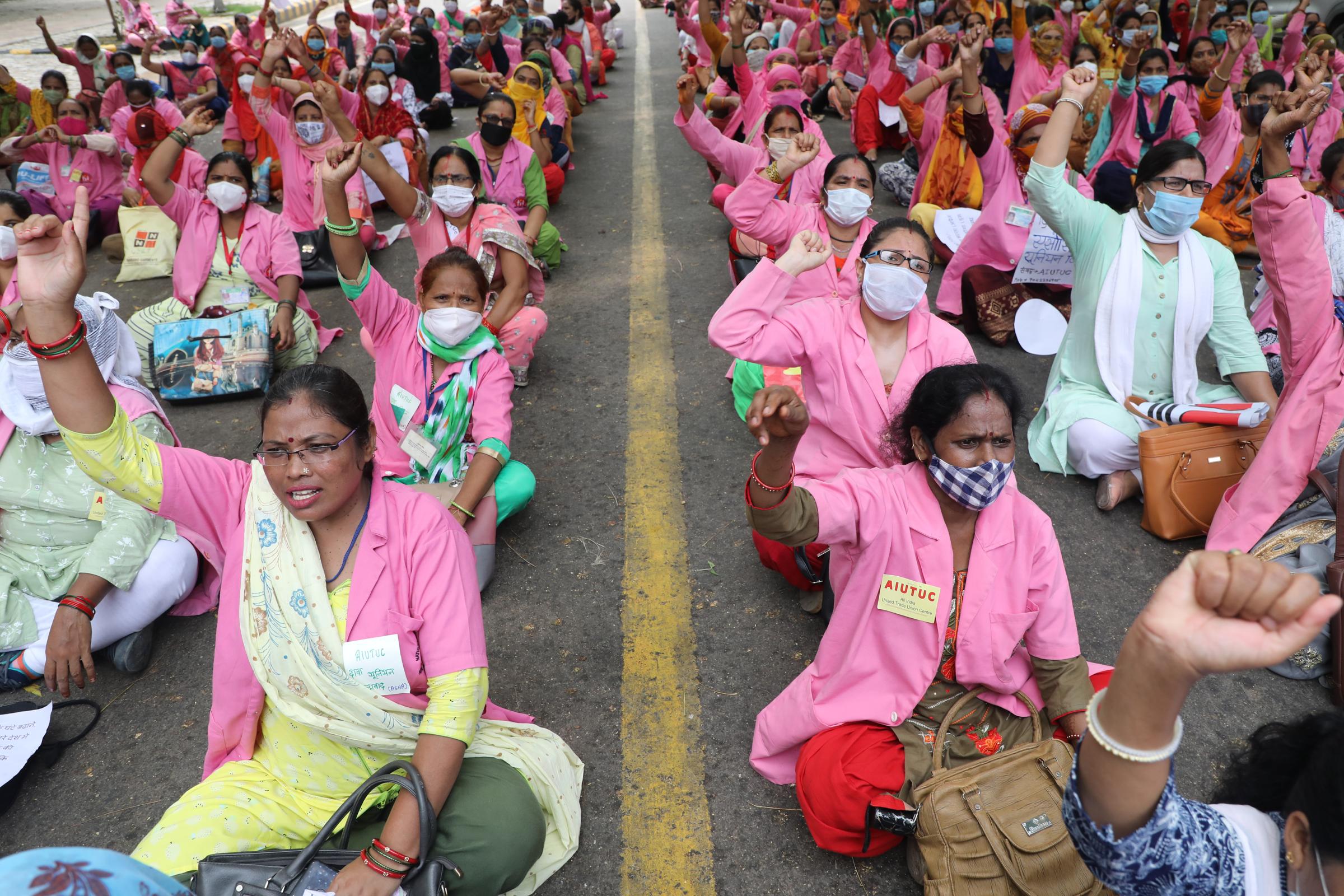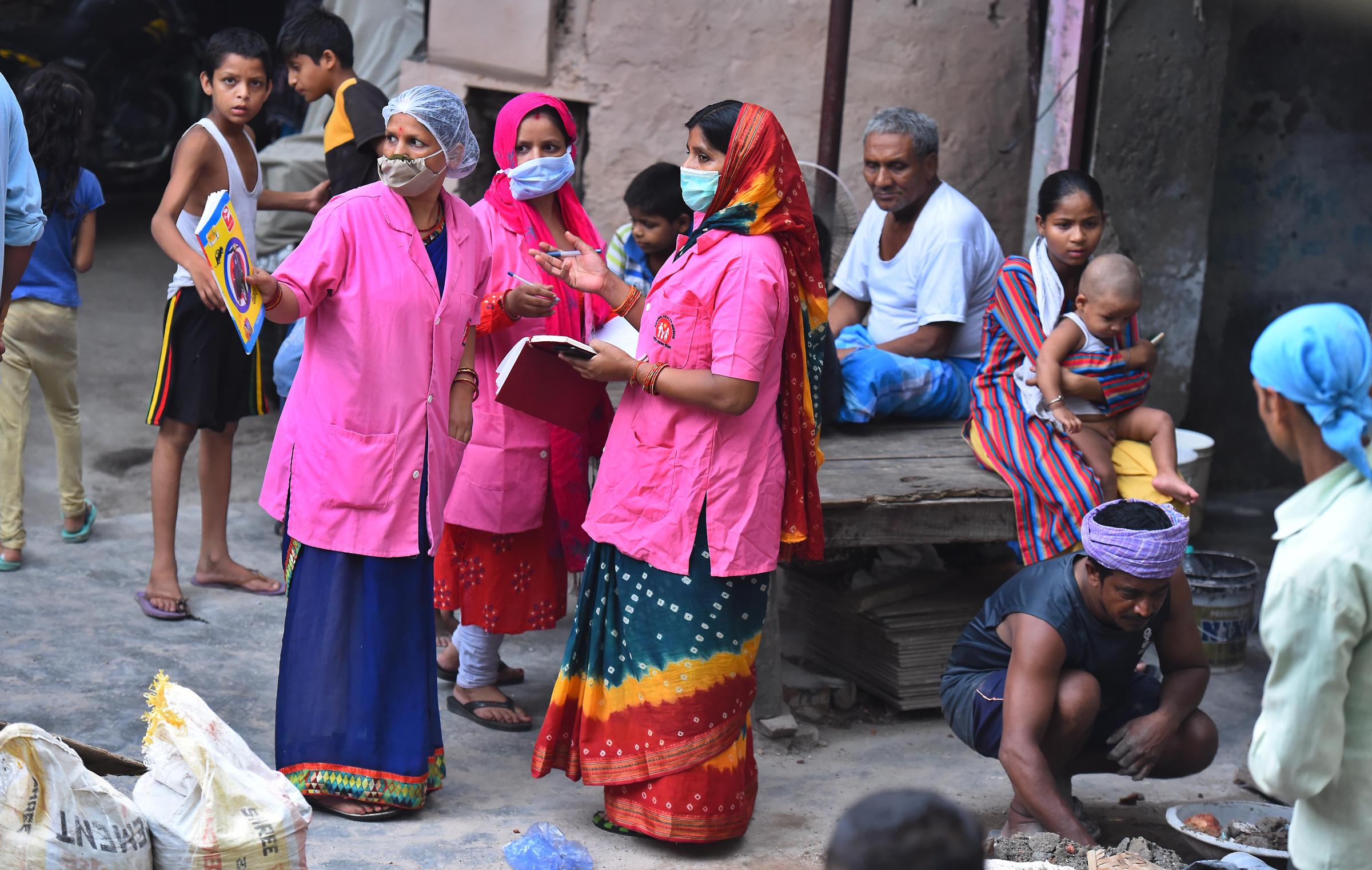Archana Ghugare’s ringtone, a Hindu devotional song, has been the background score of her life since March. By 7 a.m. on a mid-October day, the 41-year-old has already received two calls about suspected COVID-19 cases in Pavnar, her village in the Indian state of Maharashtra. As she gets ready and rushes out the door an hour later, she receives at least four more.
“My family jokes that not even Prime Minister Modi gets as many calls as I do,” she says.
Ghugare and nearly 1 million other Accredited Social Health Activists (ASHAs) assigned to rural villages and small towns across India are on the front lines of the country’s fight against the coronavirus. Every day, Ghugare goes door to door in search of potential COVID-19 cases, working to get patients tested or to help them find treatment.
With 8 million confirmed COVID-19 cases, India has the second-highest tally in the world after the United States and its health infrastructure struggled to cope with the surge in COVID-19 patients this summer. India spends only 1.3% of its GDP on public health care, among the lowest in the world. The situation is stark in rural areas where 66% of India’s 1.3 billion people live and where health facilities are scant and medical professionals can be hard to find.
India’s ASHA program is likely the world’s largest army of all-female community health workers. They are the foot soldiers of the country’s health system. Established in 2005, a key focus of the program was reducing maternal and infant deaths, so all recruits are women. They have also played an essential role in India’s efforts to eradicate polio and increase immunization, according to numerous studies.
Read More: How the Pandemic Is Reshaping India
But even as health authorities have leaned on ASHAs to quell the spread of COVID-19 in rural areas, where a substantial number of new cases have been reported, many of these health care workers say the government is failing them. Pay was meager to begin with, but some workers have reported not being paid for months. Their hours have increased dramatically, but pay rises, when they have come, have not reflected the increased demands. ASHAs in some parts of the country are earning as little as 3,000 rupees ($40) per month to fight the pandemic. Many have also complained about not being provided adequate protective equipment for their high-risk work.
“They are the unsung heroes who are fighting to contain the unfettered spread of the virus in rural areas,” says Dr. Smisha Agarwal, Research Director at the John Hopkins Global Health Initiative. She argues it is vital to improve pay to boost morale and sustain this frontline workforce.
—
Ghugare was chosen from her village of 7,000 people in 2011. Since then, she has overseen countless births, meticulously monitored the health of thousands of newborn babies and strictly ensured immunization through door-to-door awareness campaigns. The personal relationships she built over the years have helped in the fight against COVID-19, giving her a good grasp of the medical histories of most of the 1,500 people assigned to her. “It’s all in here,” she says pointing to her head.
Before the pandemic, she was expected to work two to three hours per day, for which she was paid about 2,000 rupees ($27) a month, with incentives for completing tasks in the community. Now, she’s spending 9 to 10 hours a day working to combat COVID-19. She had to cut back her other job working at a farm, and most of the bonuses have dried up as well. The Indian government has given her a 1,000-rupee ($13.50) COVID-19 stipend, but that doesn’t make up for the lost income.
Conditions like these are pushing many of these women to breaking point. Some 600,000 ASHAs went on strike in August to demand better pay and recognition as permanent government employees. (They are currently classified as volunteers, which renders them ineligible for minimum wages and other benefits.)
“The extra work we used to do earlier to ensure our stomachs weren’t empty has stopped now,” Ghugare says.

Heading out the door, she puts on a face mask and headscarf to protect herself while mentally running through the symptoms of one of the possible COVID-19 patients she had been phoned about earlier. Knowing that the individual suffers from diabetes, which makes people more vulnerable to coronavirus, Ghugare begins working out how to prioritize the case and arrange transportation to a center, about 40 minutes away, for urgent testing.
Some cases are particularly challenging. There are days when villagers refuse to talk to her. Worried about being forced to go to the hospital and missing work—a major hardship when people depend on daily wages for a hand-to-mouth existence—people often hide symptoms. Then there is also the menace of fake news, often spread on WhatsApp.
Ghugare arrives at a house in the sweltering heat, where it takes her almost 20 minutes to persuade a man to get his wife tested for COVID-19. Because of a false rumor spread via messaging apps, he is convinced his wife’s kidneys will be removed if she goes to hospital. In the end, he relents. “Dealing with fake WhatsApp forwards is one of the most exhausting parts of the job,” Ghugare says.
By around 1:30 p.m., she has already worked six hours. Before the pandemic, she would have wrapped up and headed to her second job. But now she still has a long list to get through to meet her daily target of visiting 50 houses.

—
Demands like these have driven many ASHAs to protest. “We are warriors who were sent to war without any weapons,” says Sunita Rani, an ASHA from the northern state of Haryana. She has been protesting against the state government since July and says she won’t give up until their demands are met. “If we can fight a virus, we definitely know how to fight our governments.” The Indian government hasn’t yet responded to their demands for permanent government employment.
Most health experts seem to agree that ASHAs are underpaid. But making their roles full-time is more complicated. “The beauty of this role is the mix of incentives that tend to energize ASHAs to perform better,” says Dr. Jyoti Joshi, the director of South Asia at the Center for Disease Dynamics, Economics and Policies, a public health research organization. She says retaining the incentives for completing tasks might be one solution.
Pay varies by state, and salaries can range from 2,000 rupees ($27) to 10,000 rupees ($135) per month, according to a national union for ASHAs. Many workers also depend on receiving bonuses. For instance, Ghugare receives 100 rupees ($1.25) if she vaccinates a child against measles, mumps and rubella and 600 rupees ($8) for delivering a baby for a family living below the poverty line.
Some economists argue that making nearly a million female health care workers full-time employees, and paying them more, will not only benefit India’s health system but might also help revive the country’s battered economy, one of the worst hit by the pandemic. “Employing and putting wages into the hands of so many people will definitely be beneficial to the rural economy, ” says Dipa Sinha, an economist at the Ambedkar University in New Delhi.
It might also help recover India’s plummeting rate of female workplace participation, for which the country is among the bottom 10 in the world. Experts have attributed this to cultural attitudes and the slowdown in the agricultural sector, where most rural women work. Sinha says that this gender disparity plays into the issue of ASHAs not being recognized for their work. “Who volunteers for six to eight hours a day?” she says. “It’s because they are women that their work is undermined. You can’t do this to a cadre of men.”
Ghugare shares that sentiment although she didn’t take part in the protests. With her two children growing older, expenses are increasing. An increased salary with benefits would help her give her family a better life.
As she walks back home at dusk, she knows her day isn’t done yet. There is household work to get to before getting started with a report on the day’s survey. It will be midnight before she calls it a day. That is, if the phone doesn’t ring again.
“It feels like there is a sword over our heads,” she says. “A hanging sword.”
—Additional reporting by Avantika Mohan
More Must-Reads from TIME
- Cybersecurity Experts Are Sounding the Alarm on DOGE
- Meet the 2025 Women of the Year
- The Harsh Truth About Disability Inclusion
- Why Do More Young Adults Have Cancer?
- Colman Domingo Leads With Radical Love
- How to Get Better at Doing Things Alone
- Michelle Zauner Stares Down the Darkness
Write to Abhishyant Kidangoor at abhishyant.kidangoor@time.com